Editor’s Note: This article was originally published in Overland Journal, Gear Guide 2017.
As the winter months continue, and we dream of camping inside a warm van, we decided to look back on one of our favorite builds ever. We hope you enjoy it as much as we did! – Chris Cordes
Unexpected snow flurries chill our fingers as we excavate through abrasive granitic soils. Our rental SUV is loaded beyond the GVWR and can’t access the site, so we hump in the gear. The battery in the alleged MIL-SPEC field laptop abruptly quits, and my waterproof jacket is not keeping the record forms dry. Meanwhile, our portable printer is sucking all life from the SUV’s battery, and fuel for the auger spills onto the pristine carpet. The technical report must be submitted by year’s end (3 days away), it’s a 6-hour drive back to the office, and the corporate client is losing their cool. Good times.
Field professionals nod in shared sympathy when it comes to discussing work conditions. Regardless of often miserable environments, projects are regulatory driven and subject to hard and fast deadlines. Everything has to be addressed before leaving the site because you may not have access to that location again. You learn to adapt and overcome in the field, but in most cases, you still need to transcribe information to digital format back at an office, hotel, or base camp.
But what if you were able to bring your workstation to the field? Data collection, typing reports, charging batteries, printing project maps, verifying data, or grabbing an archive for that extra file all become possible. A mobile office would also provide respite from freezing rain or blistering heat, and a place to fetch a cold beverage or prepare hot soup. And a 4WD office could get to remote locations with ease and also be enjoyed as an overland camper.
THE RIGHT VEHICLE FOR THE JOB
With the primary intended applications and location (the Americas) in mind, one vehicle stuck out as a potential mobile field office: the venerable Ford E350 extended body van. The available interior space, payload capability, and various 4WD conversions made this a clear choice. It would be built out as light as possible with an emphasis on capability and simplicity, with a versatile, modular, and accessible interior. There needed to be space for a small field team, personal gear, excavation and technical equipment, and enough room to work comfortably for extended periods.
THE BEST 4WD CONVERSION
Sportsmobile’s well-executed Ford E-Series 4WD van conversion, which exhibits years of custom build experience and design evolution, was the logical choice. The most notable difference from other builds is that the van was received completely empty. When I drove away from Alan Feld’s impressive Sportsmobile West facility in Fresno, California, the van had a driver seat, one passenger seat (co-pilot position), their bombproof 4WD conversion and familiar penthouse top, aftermarket bumpers and side ladders—and nothing else.
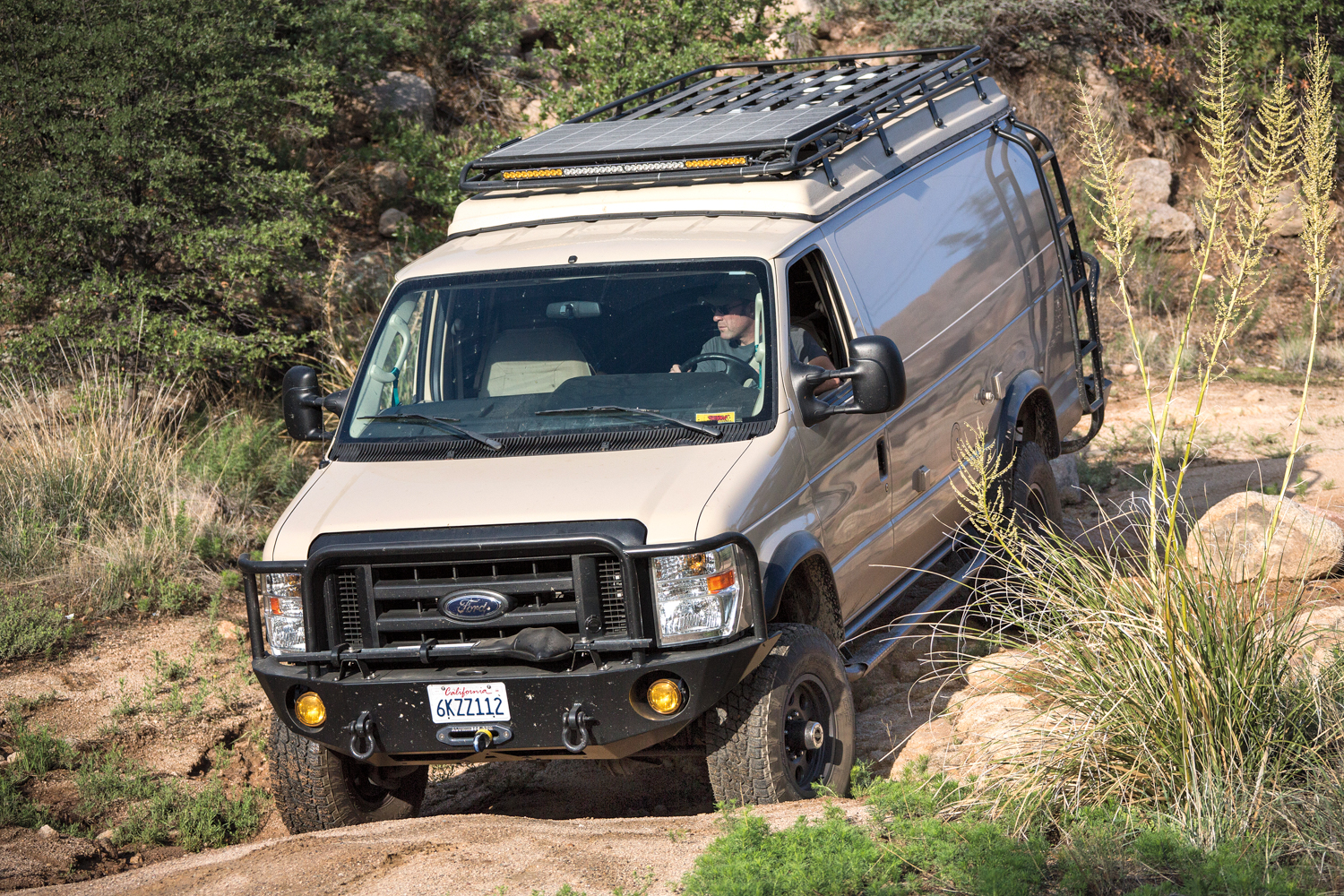
For the drivetrain, Sportsmobile took no prisoners. Ford F550 brake rotors and modified calipers were installed for greater stopping power (allowing for more rim/tire choices). Dynatrac’s ProRock 60 front and full-floating rear axles pushed stock parts to the scrap bin. An Advance Adapters Atlas 2 gear-driven transfer case keeps both differentials moving. Warn’s Premium locking hubs are complemented by ARB front and rear Air Lockers for true four-wheel traction. Also down under, Old Man Emu Dakar military wrap leaf springs and Fox shocks cushion the ride and improve articulation.
A heavy-duty steering arm and a larger diameter front sway bar with quick disconnects were added. To protect the body and provide a mounting point for the winch, I selected Aluminess Trojan front and rear bumpers. A generous sub-floor cargo hold pushed the former spare tire to the swing-out. A 46-gallon, long-range fuel tank enabled sustained travel time in the field. Other than fitting an Amsoil dual remote oil filtration system, Sportsmobile left the motor stock. A DOT-approved removable captain’s chair just inside the starboard barn doors, a custom, low profile Aluminess roof rack, and a Kyocera 185-watt solar panel were all later installed.
The van was ordered with Nitto’s Terra Grappler A/T, E-rated tires mounted on American Racing wheels. These worked with the factory low air pressure sensors and ran fine in mud and snow, but started to thin out at just over 30,000 miles. For replacements, I opted for Nitto’s improved A/T Terra Grappler G2 285/75R17. The newer version has a slightly higher road noise, which is easily addressed by the Kenwood satellite radio.
The van was capped by an electric motor-actuated fiberglass penthouse. After taking ownership, Fowler Collision Center, also in Fresno, sprayed the van’s interior, exterior wheel wells, and lower exterior panels in Raptor liner. This material provides a close color match to the stock paint and is the same product used on the roof.
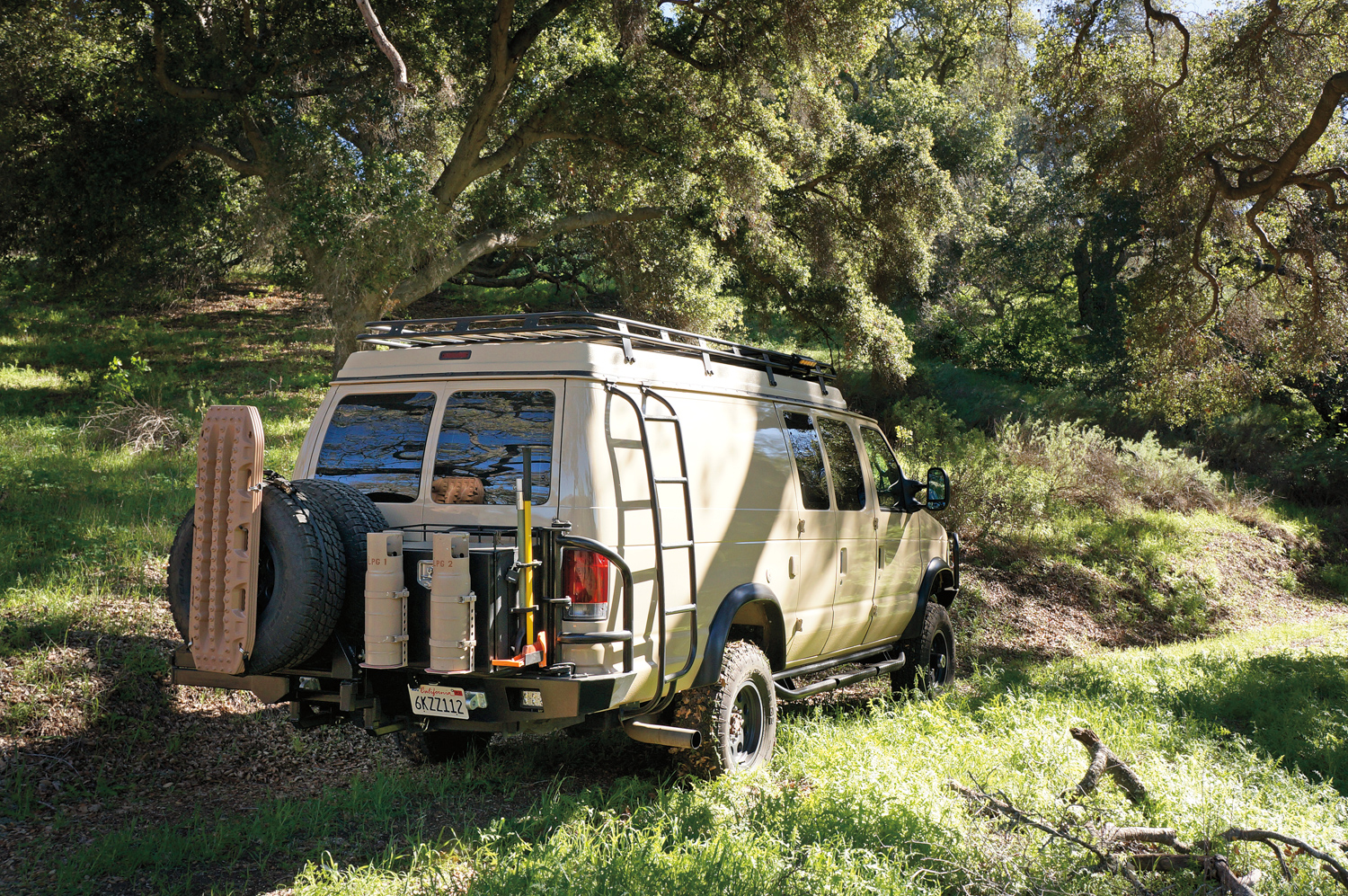
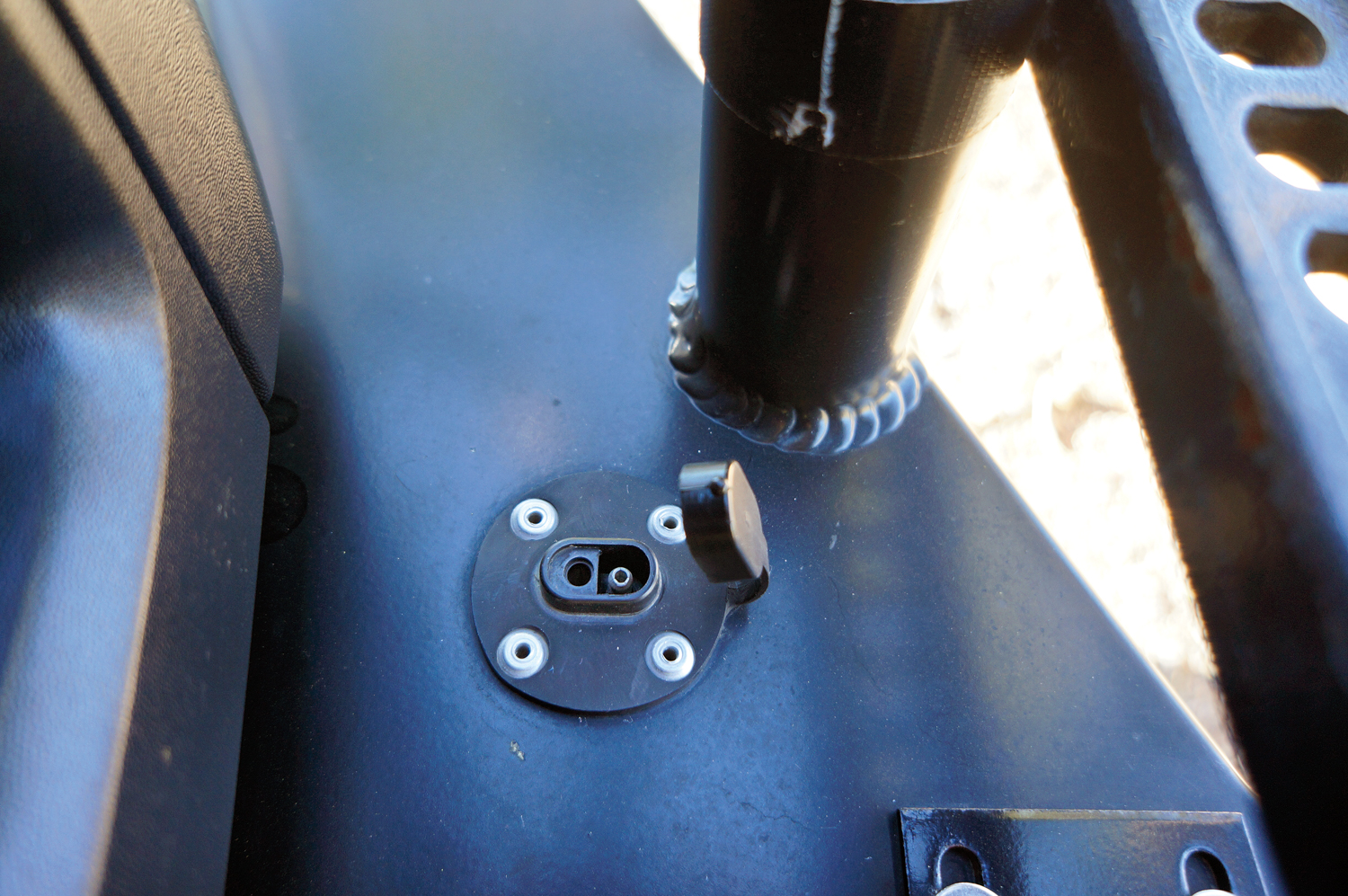
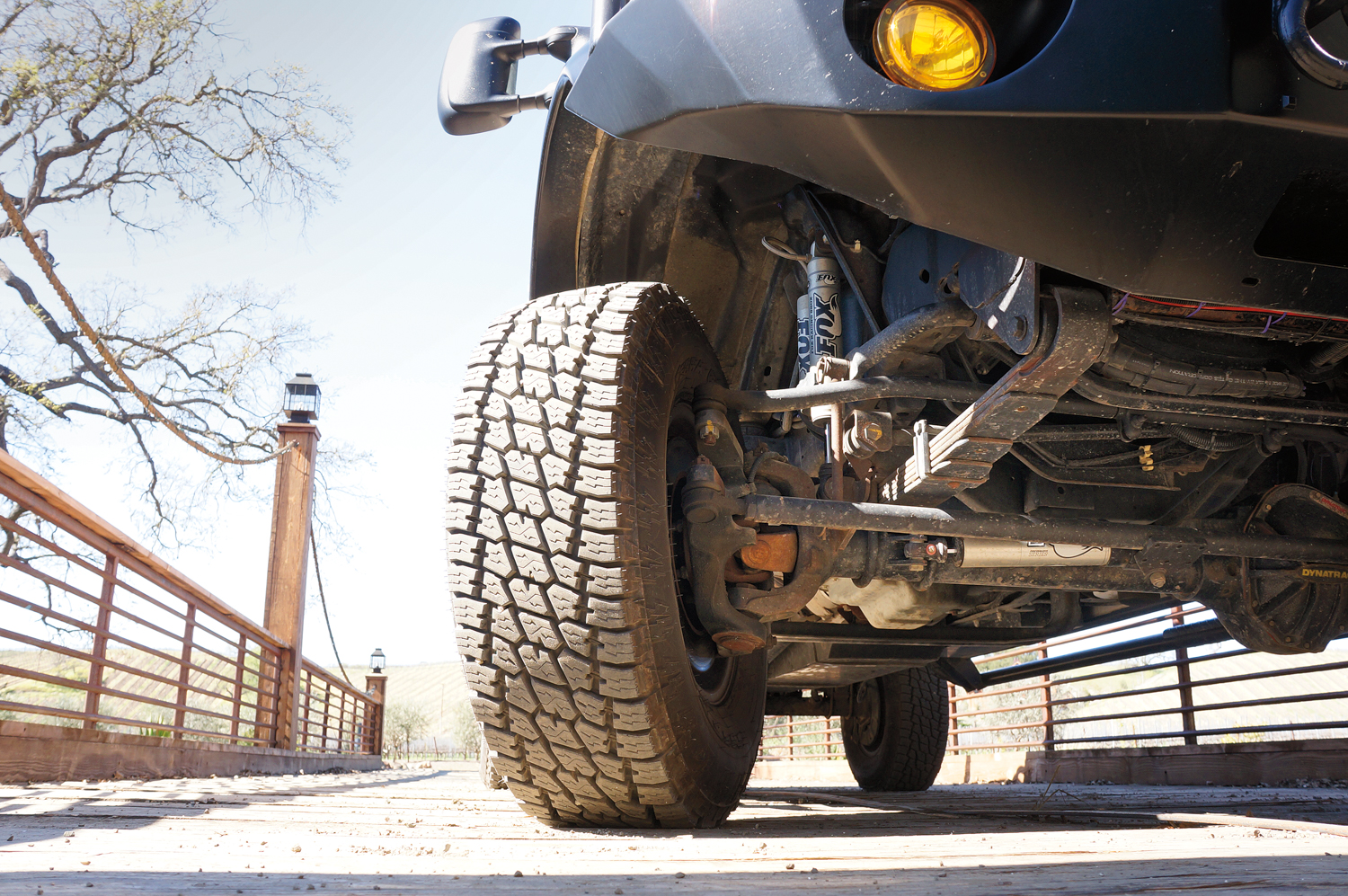
OFFICE INTERIOR WITH CARGO PLANE COMFORT
I met with Mario Donovan, co-owner of AT Overland Equipment and Adventure Trailers early on. We discussed the interior build concept and more than a year later I drove the empty 4WD van out to the AT shop in Prescott, Arizona. We mocked up proposed installations with tape, and went through various iterations of If this item is mounted here, would that open? Can this function? Can someone sit here or get through there? After 3 days, we produced a detailed plan based around a modular cargo plane-style interior.
AT custom-built and installed a master control panel down the upper port side of the interior. Where possible, we went with marine grade components to improve reliability and minimize downtime (critical to the working field professional). Blue Sea breaker switches were chosen to keep electrical components in check. The rationale is that it would be easier to identify and reset breakers without fumbling through a selection of fuses or hunting for hidden panels. Intuitive systems were a focus, especially since various people could be operating inside the van.
Within the master control panel, AT also installed separate 120VAC shore power and 120VAC battery distribution panels, a sine wave remote control (for a 2000-watt inverter), a solar panel charge controller, and a water level monitor (for AT’s custom water tank). They also mounted an Espar D5 heater controller, multiple 12-volt cigarette lighter-type sockets, a 12- volt Hella-style socket (for the 95-liter National Luna refrigerator), ample USB charger sockets and 120VAC outlets, and Hella marine red/white LED flex lights.
AT fabricated boxes to house the two deep-cycle and separate starter batteries. They also dropped in a 30-gallon BPA-free water tank between the frame rails and protected it with a skid plate. This tank feeds starboard and port external showers and a small interior stainless sink. To save weight and space, the sink drains straight out to a portable plastic tank (no fixed gray water tank). If the marine-grade Whale water pump fails or power is lost, no worries, the system is redundant: just twist two valves and use the foot pump. City water can also be connected to the van.
To heat the interior space and water, AT chose the Espar D5 system that runs off diesel from the fuel tank, running glycol lines around the outside of the water tank to keep the water from freezing. The glycol can be heated directly either by shore power or a generator—a nice touch. A frame of 80/20 aluminum bolted to the floor and protected by Nomex panels secures the sink and 95-liter National Luna refrigerator. Maximizing interior storage, AT integrated hinged access doors (one also serving as a fold-down table) into the aluminum barn door panels.
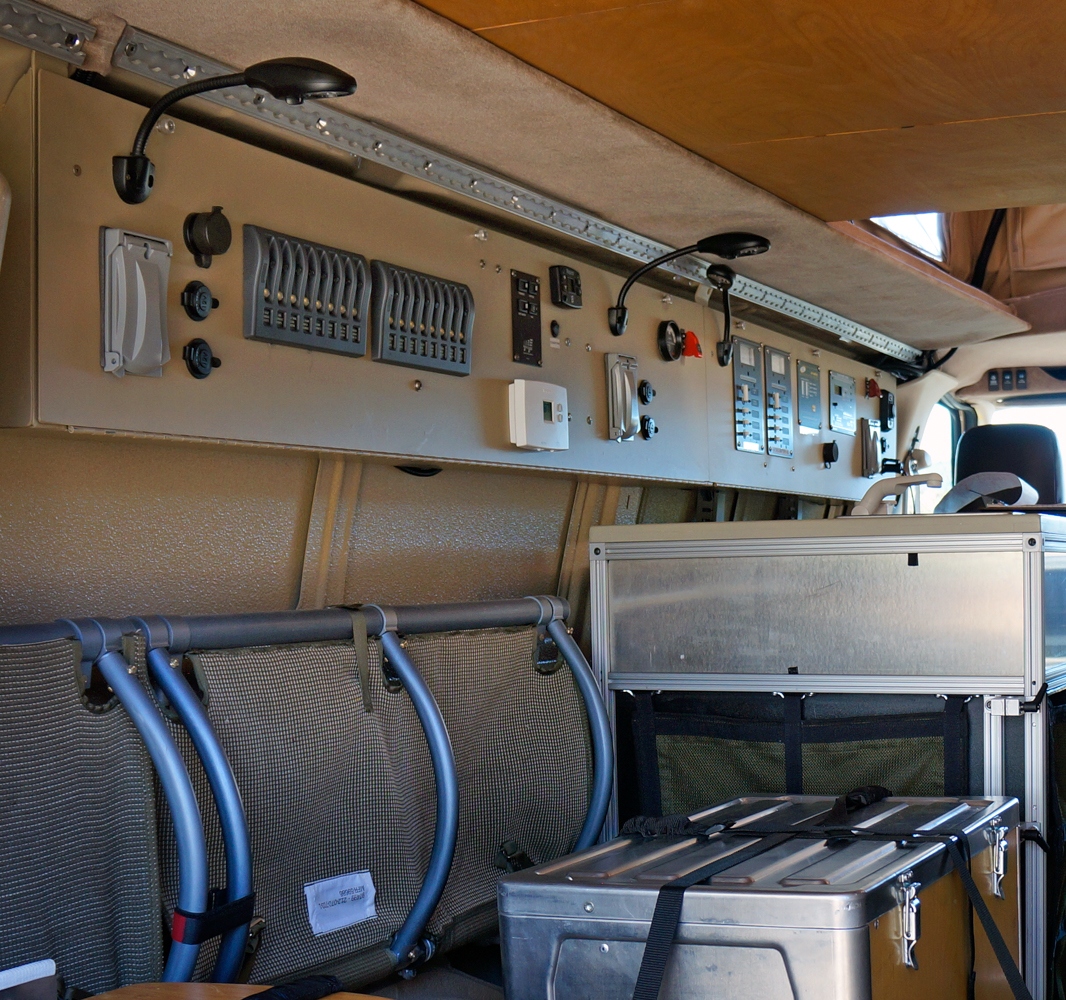
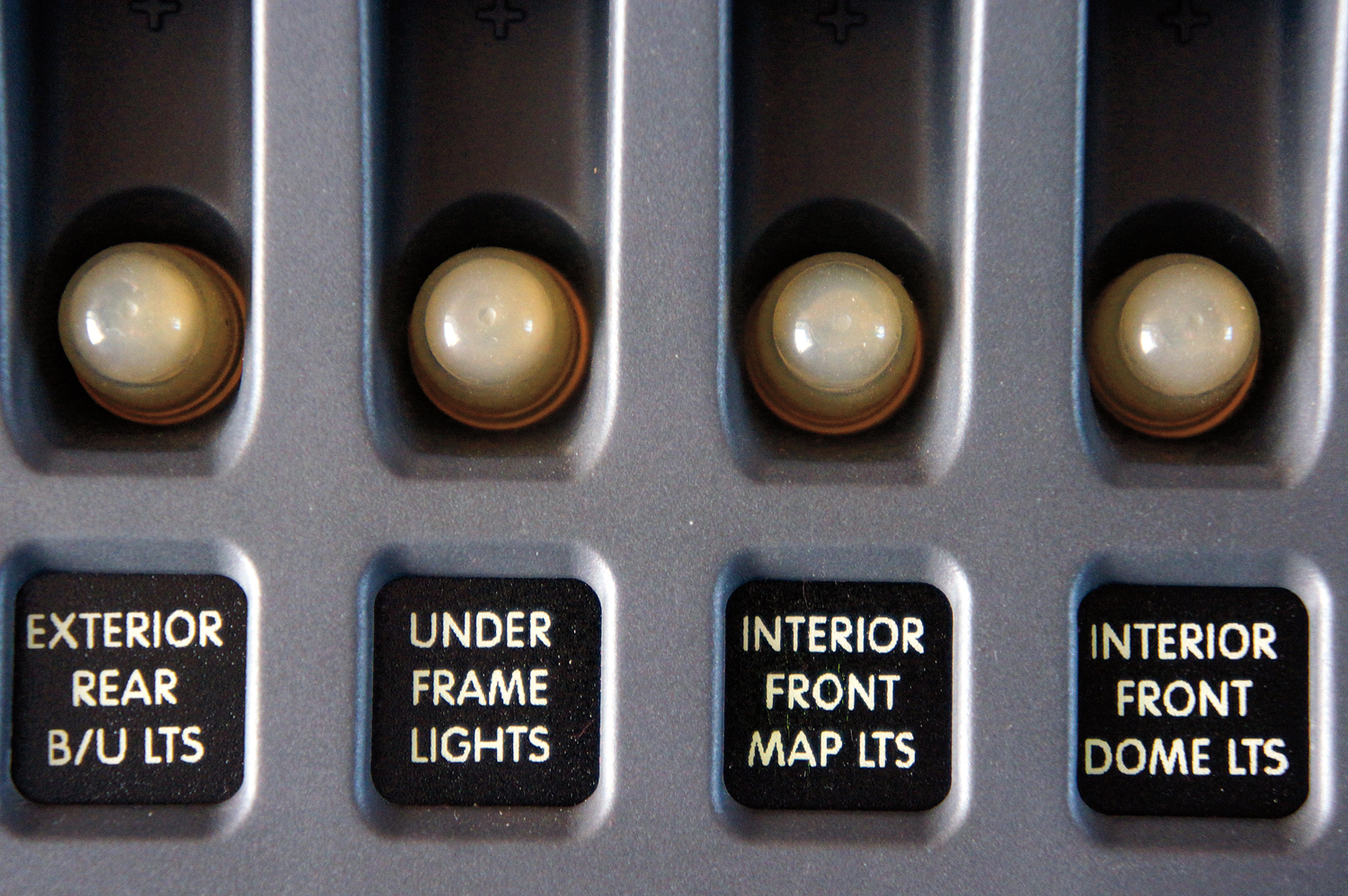

Except for the factory dash lights, all interior lights are LED. This took some ingenuity with the dome lights, which normally actuate upon opening doors. They now stay off until manually switched on. To the Aluminess roof rack, we bolted a 40-inch LED light bar up front and two 10-inch light bars to starboard and port, all sourced from Baja Designs. To maximize the interior’s versatility, AT mounted four new old stock Huey (Bell UH-1) military helicopter seats in the van. these weigh almost nothing, fold down as individual seats or together as cots, and make a perfect aft lounge and meeting area. Aluminum aircraft L-tracks throughout the van allow cargo to be secured, while off-the-shelf Pelican cases, attached to aluminum staves mounted along the interior sides (courtesy of Aluminess), provide extra storage. The Aluminess team also came through with a ladder to access the penthouse bunk.
For some additional wiring and suspension work, I was directed to a local (California) shop called NTG Racing. There I found someone in surfer shorts, with acupuncture needles sticking out of his knee, wrenching on a shock. That someone was owner Joe Salas. Joe does truck repair and also builds specialized chase trucks for desert racing teams. With tan Scepter fuel cans everywhere and off-road racing legend Malcolm Smith’s Dodge truck in for repairs, I knew this was the right place. Somehow, we ended up at the nearby Fox factory and after a chat with their R&D crew, they agreed to set up four 2.0 remote reservoir shocks. The engineering team recommended beefing up the shock towers too, so Joe and his team made that happen in full go-fast glory. NTG also installed Fox’s 2.0 ATS proprietary steering stabilizer. These modifications changed the vehicle’s ride and handling considerably.
A 4WD OFFICE REALIZED
This project called upon various specialists stretching from racing, expedition, and overland backgrounds, to daily-driver diesel truck repair. With the exception of the 4WD conversion, much of the interior build and systems integration is one-off. Along the way, ample troubleshooting occurred, parts were swapped, and initial designs were tweaked. The vehicle exceeds my original 4WD mobile office concept but remains a tightly efficient working space. The extra costs of the vehicle are recovered in productivity gains—and being able to sauté one’s evening meal by campfire instead of eating dodgy take-out from a roadside motel.
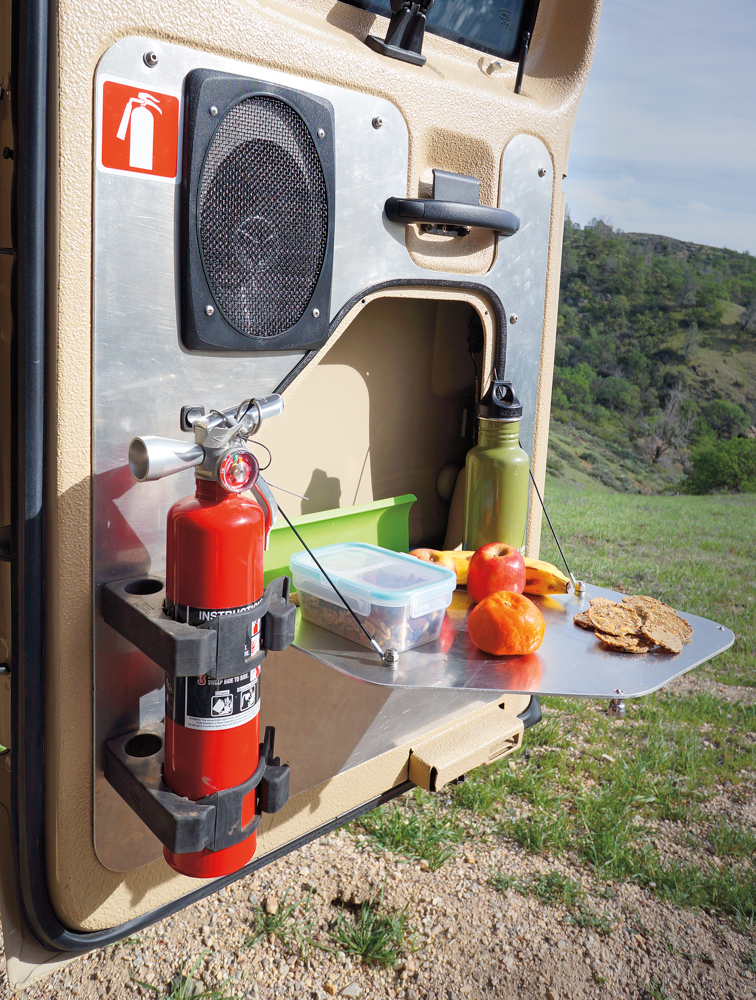

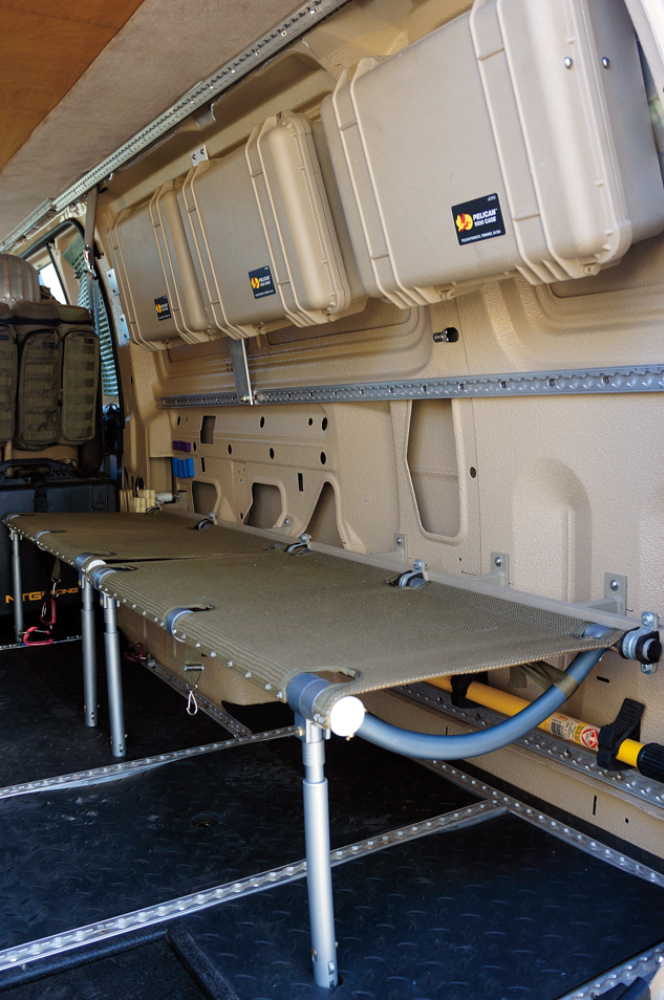
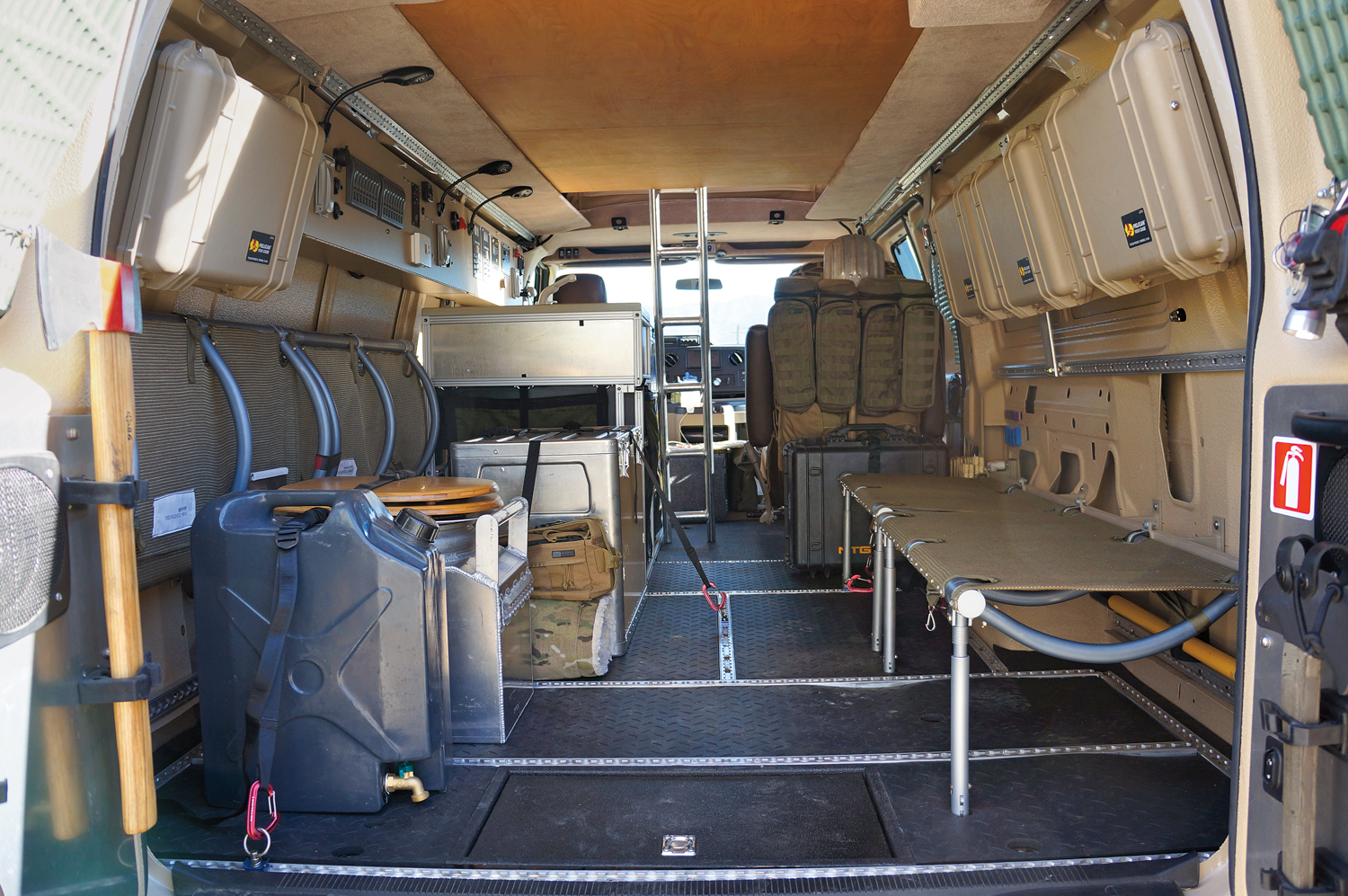

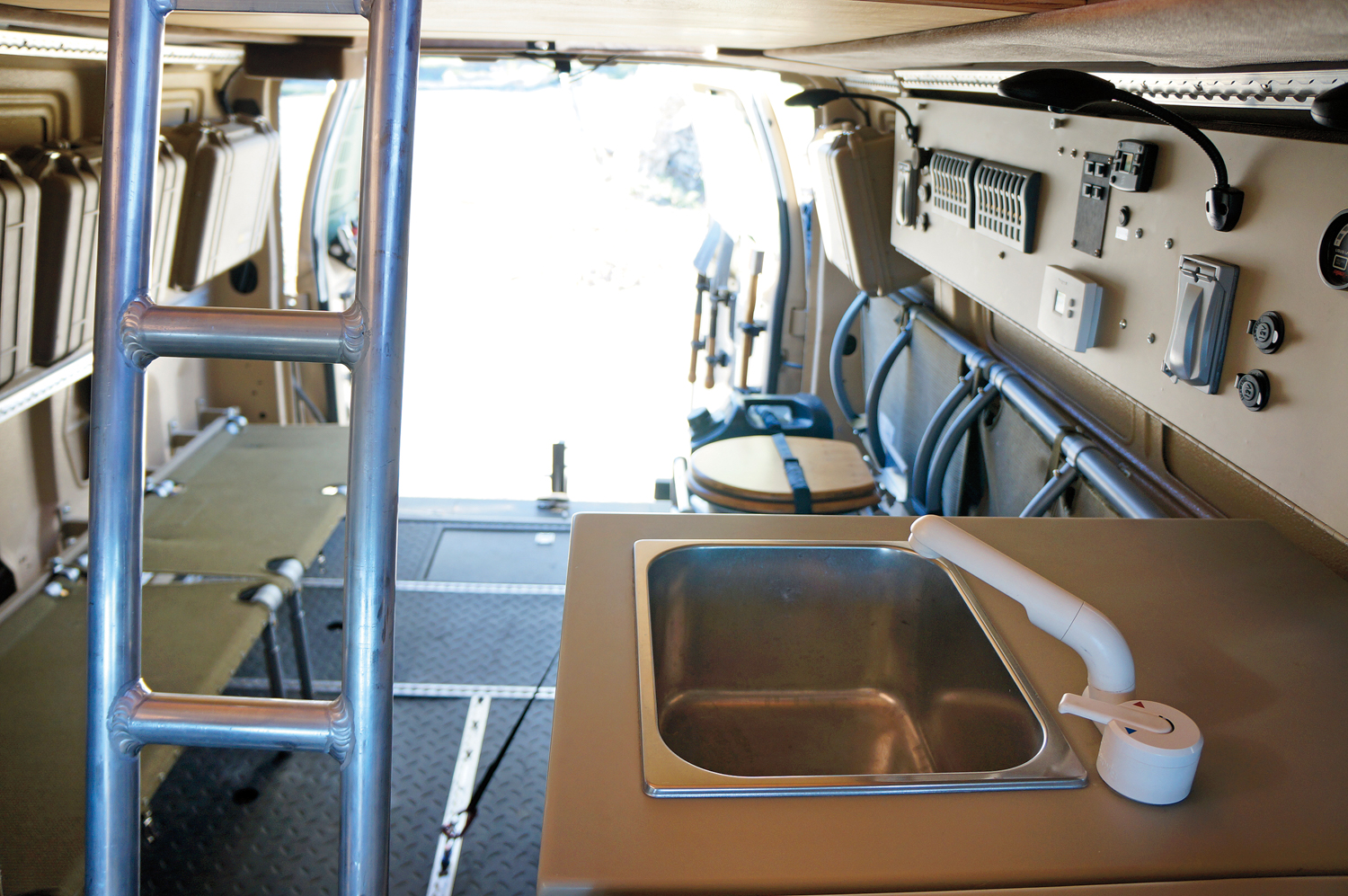

Power
• 6.0L Powerstroke V8 engine (VT365 diesel)
• 5-speed automatic transmission w/overdrive
Suspension/Drive
• Nitto A/T Terra Grappler G2 285/75R17 (two spares)
• Dynatrac ProRock 60 front and full-floating rear axles
• Advance Adapters Atlas 2 transfer case
•ARB air lockers (front and rear)
• Old Man Emu Dakar military wrap leaf springs
• Fox 2.0 remote reservoir shocks
• Fox 2.0 Adjustable Through Shaft (ATS) steering stabilizer
• Ford F550 disk brakes
Recovery and Armor
• Warn 16.5ti winch with Viking Offroad 7/16-inch synthetic line
• Aluminess Trojan bumpers
Accessories
• National Luna refrigerator (95L)
• Kyocera solar panel (185W)
• Espar D5 heat exchanger
• AT custom BPA-free H2O tank (30 gal)
• Whale water pump
• Fireboy-Xintex LL1 liquid level monitor
Lighting and Electric
• Baja Designs Stealth LED light bars (front and sides)
• Baja Designs frame-mounted LED rock lights
• Baja Designs Soltek Fuego 4-in HID lights (in front bumper)
• Hella LED lights (in rear bumper)
• Intelligent Battery System (IBS)
• Go Power! electric sine wave remote control
• Blue Sky Energy solar panel manager
• Blue Sea breaker switches with custom labels
• Blue Sea 120VAC distribution panels


